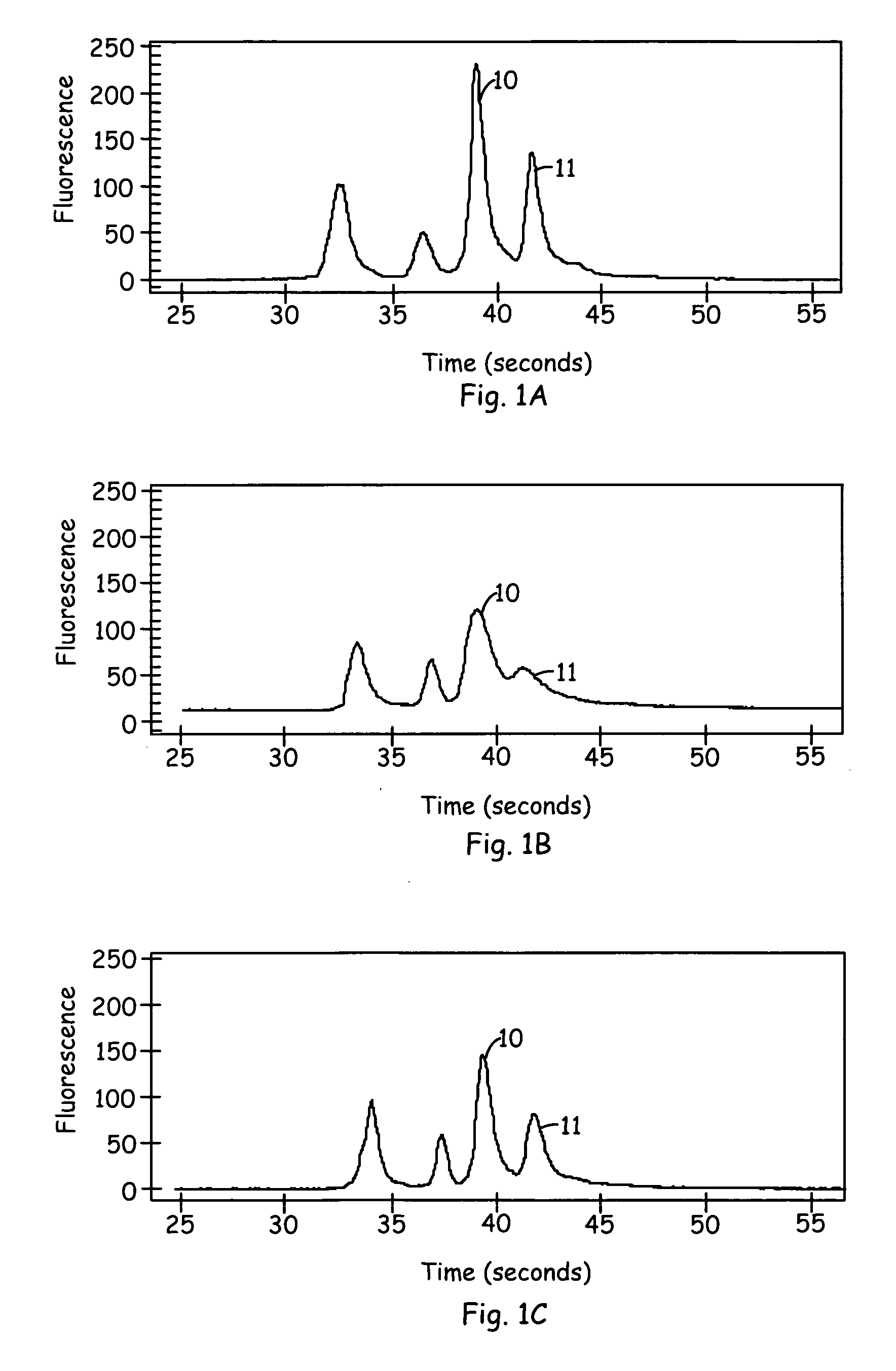Reduction of migration shift assay interference
a technology of migration shift and interference, applied in the field of reducing migration shift assay interference, can solve the problems of inability to validate the results of a shift detection or quantitative assay, non-specific binding sample constituents can interfere with the detection of migration shift measurement, and reduce the sensitivity and/or accuracy of migration shift analysis, so as to reduce the interference of sample constituents
- Summary
- Abstract
- Description
- Claims
- Application Information
AI Technical Summary
Benefits of technology
Problems solved by technology
Method used
Image
Examples
example
Example 1
[0219] The following non-limiting Example illustrates the use of heparin sulfate as the charged polymer for blocking serum interference in an alpha-feto protein immunoassay.
[0220] Reagents:
[0221] Gel: 2.5% pDMA / 3% glycerol / 0.05% Tween20 / 0.1% BSA / 150 mMHEPES / NaCl / 2.5 mg / ml LCA (pH: 7.5).
[0222] Buffer for serum samples (hereinafter abbreviated as sample buffer): 7.5 mM HEPES / 0.025% Tween-20 / 0.1% BSA+20 nM anti-AFP monoclonal antibody WA-2 IgG (pH: 7.5). The monoclonal antibody was prepared in house.H. Katoh et al., Anal. Chem. (1998) 70, 2110-2114).
[0223] Buffer for antibody (hereinafter abbreviated as antibody buffer): 7.5 mM HEPES / NaCl / 0.025% Tween-20 / 0.01% BSA (pH: 7.5).
[0224] Labeled anti-AFP antibody / DNA conjugate: 3 nM of 4Alexa Fluor 647 anti-AFP monoclonal antibody WA-1-140 bp DNA conjugate; Alexa Fluor 647 dye was purchased from Molecular Probes, Inc. (Eugene, Oreg.), and the DNA charged carrier molecule was prepared by PCR reaction. The anti-AFP monoclonal ant...
example 2
[0229] The following non-limiting Example illustrates the use of ITP in an AFP assay with serum, and an example of an electrophoregram showing the results with 5% serum with and without 0.01% Poly dI-dC. In this Example, poly(dI-dC) was used instead of heparin sulfate as a charged polymer to remove serum interference. The concentration of poly(dI-dC) was approximately 0.01% (w / v).
[0230] Leading buffer: 15 mM Tris / 50 mM NaCl / 0.9% pDMA / 0.05% Tween-20 / 0.01% BSA
[0231] Trailing buffer: 15 mM Tris / 25 mM HEPES / 0.9% pDMA / 0.05% Tween-20 / 0.01% BSA
[0232] Sample in a leading buffer with 10% serum and 100 nM anti-AFP monoclonal antibody WA-2 IgG, 100 ug / ml poly(dIdC). The monoclonal antibody was prepared in house (H. Katoh et al., Anal. Chem. (1998) 70, 2110-2114).
[0233] Binding reaction was performed off chip, by mixing a sample with Ab solution 1:1.
[0234] Labeled anti-AFP antibody / DNA conjugate: 500 pM of 2Alexa Fluor 647 anti-AFP monoclonal antibody WA-1-140 bp DNA conjugate; Alexa Fluor...
example 3
[0237] The following non-limiting Example illustrates the use of DNA as the charged carrier molecule for concentrating a CA19-9 sample.
[0238] Leading buffer: 15 mM Tris / 50 mM NaCl / 0.2% pDMA / 0.05% Tween-20 / 0.01% BSA
[0239] Trailing buffer: 15 mM Tris / 25 mM HEPES / 0.2% pDMA / 0.05% Tween-20 / 0.01% BSA
[0240] Labeled anti-CA19-9 antibody: anti-CA19-9 monoclonal antibody (IgG) (Biodesign international) was labeled with Alexa by mixing the antibody and Alexa647 succinimide (Molecular probes, Inc., Eugene, Oreg., USA) in 0.2M Sodium bicarbonate buffer (pH8.3) for 2 hours, and then unbound Alexa dye was removed from the mixture by applying the reaction mixture to Gel filtration and DEAE-ion exchange chromatography.
[0241] Anti-CA19-9 antibody / DNA conjugate: conjugate of anti-CA19-9 monoclonal antibody (IgG) (Biodesign international) and 250 bp DNA was prepared according to the methods described in Japanese Patent Application number WO 02 / 082083. The 250 bp DNA was prepared as follows: PCR rea...
PUM
| Property | Measurement | Unit |
|---|---|---|
| temperature | aaaaa | aaaaa |
| temperature | aaaaa | aaaaa |
| molecular weight | aaaaa | aaaaa |
Abstract
Description
Claims
Application Information
 Login to View More
Login to View More - R&D
- Intellectual Property
- Life Sciences
- Materials
- Tech Scout
- Unparalleled Data Quality
- Higher Quality Content
- 60% Fewer Hallucinations
Browse by: Latest US Patents, China's latest patents, Technical Efficacy Thesaurus, Application Domain, Technology Topic, Popular Technical Reports.
© 2025 PatSnap. All rights reserved.Legal|Privacy policy|Modern Slavery Act Transparency Statement|Sitemap|About US| Contact US: help@patsnap.com



